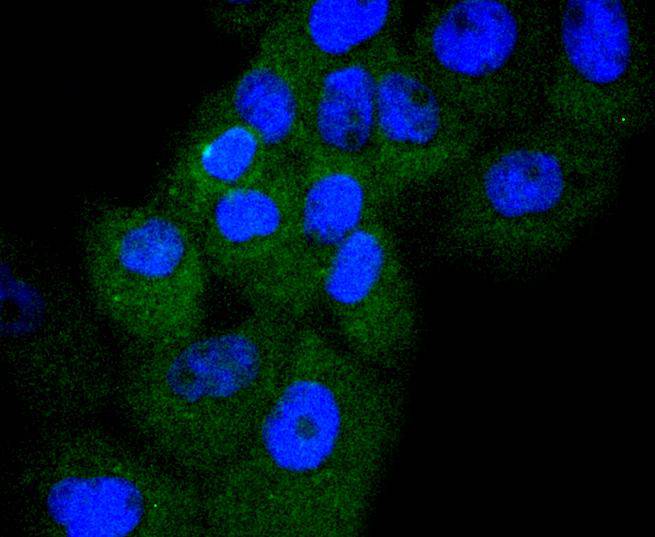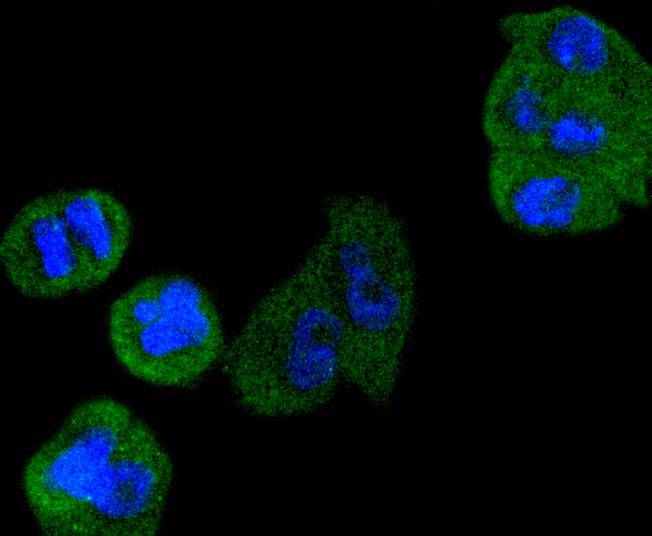Product Detail
Product NameCyclin D3 Rabbit mAb
Clone No.SD20-43
Host SpeciesRecombinant Rabbit
Clonality Monoclonal
PurificationProA affinity purified
ApplicationsWB, ICC/IF, FC
Species ReactivityHu, Ms
Immunogen Descrecombinant protein
ConjugateUnconjugated
Other NamesCCND 3 antibody Ccnd3 antibody CCND3_HUMAN antibody CyclinD3 antibody D3 type cyclin antibody G1 S specific cyclin D3 antibody G1/S specific cyclin D3 antibody G1/S-specific cyclin-D3 antibody
Accession NoSwiss-Prot#:P30281
Uniprot
P30281
Gene ID
896;
Calculated MW32 kDa
Formulation1*TBS (pH7.4), 1%BSA, 40%Glycerol. Preservative: 0.05% Sodium Azide.
StorageStore at -20˚C
Application Details
WB: 1:1,000
ICC: 1:50-1:200
FC: 1:10-1:50
Western blot analysis of Cyclin D3 on different lysates using anti-Cyclin D3 antibody at 1/1,000 dilution. Positive control: Lane 1: Jurkat Lane 2: Hela
ICC staining Cyclin D3 in Hela cells (green). The nuclear counter stain is DAPI (blue). Cells were fixed in paraformaldehyde, permeabilised with 0.25% Triton X100/PBS.
ICC staining Cyclin D3 in A431 cells (green). The nuclear counter stain is DAPI (blue). Cells were fixed in paraformaldehyde, permeabilised with 0.25% Triton X100/PBS.
ICC staining Cyclin D3 in PANC-1 cells (green). The nuclear counter stain is DAPI (blue). Cells were fixed in paraformaldehyde, permeabilised with 0.25% Triton X100/PBS.
Flow cytometric analysis of Hela cells with Cyclin D3 antibody at 1/50 dilution (red) compared with an unlabelled control (cells without incubation with primary antibody; black). Alexa Fluor 488-conjugated goat anti rabbit IgG was used as the secondary antibody.
The proliferation of eukaryotic cells is controlled at specific points in the cell cycle, particularly at the G1 to S and the G2 to M transitions. It is well established that the Cdc2 p34-cyclin B protein kinase plays a critical role in the G2 to M transition while cyclin A associates with Cdk2 p33 and functions in S phase. Considerable effort directed towards the identification of G1 cyclins has led to the isolation of cyclin D, cyclin C and cyclin. Of these, cyclin D corresponds to a putative human oncogene, designated PRAD1, which maps at the site of the Bcl-1 rearrangement in certain lymphomas and leukemias. Two additional human type D cyclins, as well as their mouse homologs, have been identified. Evidence has established that members of the cyclin D family function to regulate phosphorylation of the retinoblastoma gene product, thereby activating E2F transcription factors.
If you have published an article using product 49150, please notify us so that we can cite your literature.







 Yes
Yes



